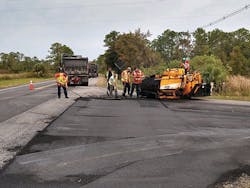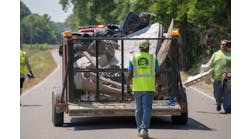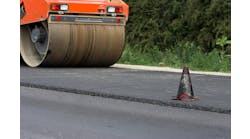A recent TRIP report found that the U.S. faces a heavy backlog when it comes to repairing and improving our rural transportation infrastructure across the country.
The same report released by the transportation research nonprofit also showed that the nation’s rural areas are in need of immediate transportation improvements to address deficient roads and bridges, high crash rates, and inadequate connectivity and capacity.
While the challenge to address the deficiencies of the nation’s rural roads and bridges is ongoing, it is worth acknowledging the work of various state DOTs as they tackle rural infrastructure. One such example is how the Florida DOT (FDOT) successfully reconstructed a more than 9-mile stretch of U.S. 441 (S.R. 15) in Okeechobee from south of NE 304th Street to the Osceola County line.
FDOT collaborated with CWR Contracting Inc. to repave and revitalize the north-south arterial that provides a direct route between Okeechobee and the Florida Turnpike access at Yeehaw Junction—which marks the confluence of U.S. 441, the Florida Turnpike, and S.R. 60.
“It was last paved in 2000,” FDOT Construction Project Manager Stacy Hill told Roads & Bridges. “So the asphalt was 18 years old. There was some shoulder joint cracking going on along the edge, and then some areas where because of the age of the asphalt, you could get some standing water after the rain. So that’s what this paving project was supposed to address. And [address] a couple of superelevations in order to help it drain better along the curves.”
Working in a narrow space
According to Hill, this corridor of U.S. 441 sees an average of 4,000 vehicles per day—including high levels of truck traffic—and connects the Lake Okeechobee tourist area and the city of Okeechobee with S.R. 60 and the Florida Turnpike.
The reconstruction of this 9-mile stretch began in October 2018. One of the main concerns for the department was setting up and maintaining a safe work zone along a two-lane open rural highway with trucks going by at rapid speeds. “It was a two-lane road with no place to have anybody turn around or redirect them away from your work zone,” Hill said. “This is where they have to go. Unless they’re gonna go at least an hour and a half out of their way to get around to get back to Okeechobee, this is it.”
The contractor utilized daily lane closures for paving work, most of which took place during the daytime as it was determined to be safer along this route to work in daytime hours. Typically about a mile and a half lane closure was implemented at a given time. The contractor also had to be mindful of coordinating with emergency services in the area, which required the ability to navigate through the work zone to make it to the turnpike should the need arise. The contractor also used flaggers at crossroads in order to help motorists navigate the work zone safely.
“We have all the advance warning signs and rumble strips to give everyone fair warning about what’s coming up on the road,” CWR Contracting Operations Manager Ryan Bittman told Roads & Bridges. “So then you have your two flaggers with radios, then you have a maintenance of traffic (MOT) specialist who drives up and down the job, makes sure the radios have batteries, and [corrects] any cones that get hit by traffic. Typically we place the cones about 2 ft from the centerline, just to give our guys a bit more working area—sometimes you’re right up against the cones.”
TWO-LANE HIGHWAY PAVING
For this stretch of U.S. 441, a warm mix asphalt was used for paving in lieu of the standard hot mix seen on many projects of this sort.
“A lot of asphalt plants are electing to go with the warmer mix—it’s just more cost effective,” Bittman explained. “And it’s a little bit for the environment. So the temperatures come in at 275° rather than your 320°. And you’re allowed 25° in both directions. Otherwise the mix is no good and you can’t put it down. And we had no loads rejected on this project either.”
According to Bittman, the contractor milled 3 in. of asphalt along the project and put back 3 in. in two lifts. The project went ahead of schedule, and the team experienced zero deficiencies on both the structure and friction lifts. “Deficiencies are checked by a rolling straightedge and they measure every sixteenth of an inch that the asphalt is off, so anything over 3/16 is considered out, and you got to repair it,” Bittman said. “We had zero, and we were running about 1,000 tons a day, if not a little bit more every day we were paving.”
The contractor said the biggest challenge during paving was coordinating the various steps in the paving process. “We probably had 10 to 15 dump trucks in front of the milling machine, and then the paving crews started maybe two hours later just to coordinate,” Bittman said. “You want to keep a good, steady speed with the paver. And that project we pretty much stayed at 25 ft a minute.”
Among the equipment the team used included a Roadtec paver, outfitted with MOBA’s big ski pole—which is about 30 ft long and is placed on the side of the paver right along the centerline. The ski pole is equipped with nine sensors in total, which allow the contractor to measure the correct depth in order to get the smoothest ride.
FDOT explained that the contractor was “very proactive” in obtaining informational roadway cores in order to monitor the quality of the mix in the lab and adjust the rolling pattern as needed to ensure minimum densities were consistently being met. This, FDOT said, resulted in 100% of the material placed on the project either meeting or exceeding specifications. The average composite pay factor for the asphalt was 1.03 with a total of 27,501 tons placed. After completion, FDOT performed laser profiling of the entire corridor, which resulted in zero deficiencies in a total of 18.8 miles tested. Both lanes of the project had an average ride number of 4.4 with no areas any less than 4.0.
Finishing up
The original contract to finish the project was awarded at 185 days, and the project lost about eight days to weather-related events. In addition, the project timeline saw about 50 “no work” days, which were needed to allow time off during CWR’s more aggressive schedule. The project was completed in approximately 127 actual days worked, and with zero work-related accidents during the project timeline.
Overall, the team at FDOT was pleased with the results of the repaving project, which faced the challenge of a tight work area and few detours to redirect traffic. “Some of the people in the area that have access directly to the roadway were pleased with the fact that those turnouts were addressed in the construction in order to reduce any wear and tear drop-off and smoother transition,” Hill said. “They like the fact the project seemed to go fairly quickly, and we didn’t impact them as long as they thought we were going to. And that the roadway—due to the new striping and RPMs [raised pavement markers]—is more reflective and easier to navigate at nighttime.”



